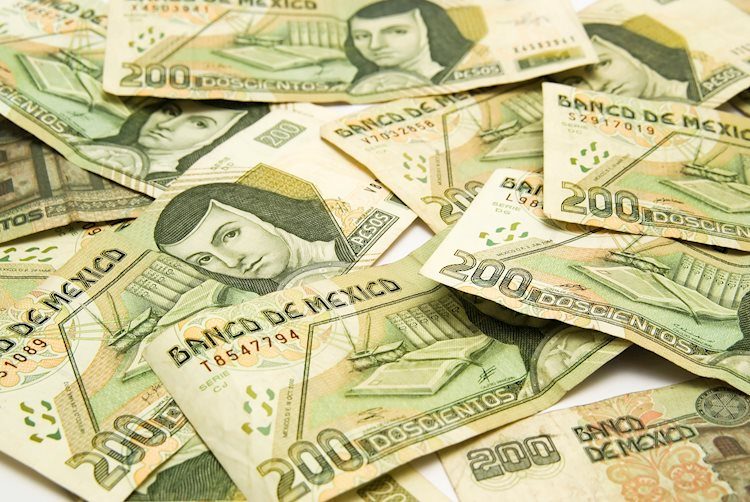- Mexican Peso erases gains after USD/MXN approached the 17.00 figure.
- Mexico’s Balance of Trade posted a deficit non-seasonally adjusted.
- Banxico’s Heath: Rates could be cut by February or March, but gradually.
Mexican Peso (MXN) is virtually unchanged against the US Dollar (USD) early during Monday’s North American session after USD/MXN hit a two-month low of 17.03. Nevertheless, the Greenback pared some losses, underpinning the USD/MXN, which trades at 17.14, up a decent 0.32% on the day.
Mexico’s economic calendar revealed a current surplus of $2.628 billion in October, equivalent to 0.6% of the Gross Domestic Product (GDP), the Bank of Mexico (Banxico) reported. In the meantime, Banxico’s Deputy Governor, Jonathan Heath, commented that core prices must come down more for inflation to keep easing. Heath added that a slowdown in the Core Consumer Price Index (CPI) could put into play a possible rate cut by February or March next year, he said in a radio interview at Imagen Radio.
On the US front, USD/MXN traders are eyeing the release of the US Federal Reserve (Fed) preferred measure of inflation, the Core Personal Consumption Expenditures (PCE) price index on Thursday, alongside employment data and an update of the Institute for Supply Management (ISM) Manufacturing PMI on Friday.
Daily digest movers: Mexican Peso could weaken next year if Banxico adopts a dovish stance
- Banxico’s Deputy Governor Jonathan Heath added that one or two rate cuts may come, but “very gradually” and “with great caution.”
- Mexico’s Balance of Trade in non-seasonally adjusted terms posted a deficit of $252 million.
- On November 24, a report revealed the economy in Mexico grew as expected in the third quarter on an annual and quarterly basis, suggesting the Bank of Mexico would likely stick to its hawkish stance, even though it opened the door for some easing.
- Mexico’s annual inflation increased from 4.31% to 4.32%, while core continued to ease from 5.33% to 5.31%, according to data on November 23.
- The financial markets’ narrative that the US Federal Reserve (Fed) is done hiking rates has kept the Greenback on the backfoot, but today, it has found some relief. The US Dollar Index (DXY) is up 0.04%, exchanging hands at 103.45.
- Data published earlier this month showed prices paid by consumers and producers in the US dipped, increasing investors’ speculations that the Fed’s tightening cycle has ended.
- A Citibanamex poll suggests that 25 of 32 economists polled expect Banxico’s first rate cut in the first half of 2024.
- The poll shows “a great dispersion” for interest rates next year, between 8.0% and 10.25%, revealed Citibanamex.
- The same survey revealed that economists foresee headline annual inflation at 4% and core at 4.06%, both readings for the next year, while the USD/MXN exchange rate is seen at 19.00, up from 18.95, toward the end of 2024
- The swap market suggests traders expect 84 basis points of rate cuts by the Fed in 2024.
Technical Analysis: Mexican Peso remains firm, but USD/MXN double-bottom could open the door for a leg-up
The USD/MXN downtrend remains in place from a daily chart perspective, but Monday’s price action suggests a ‘double bottom’ chart pattern could be emerging. Further upside above the November 21 latest swing high at 17.26 would confirm the chart pattern, targeting a rally toward 17.50. On its way north, the 100-day Simple Moving Average (SMA) at 17.34 must be cleared, followed by the 20-day SMA at 17.41.
On the flip side, a decisive breach of the 17.05 figure could open the door to test the 17.00 figure, followed by the year-to-date (YTD) low of 16.62.
Inflation FAQs
Inflation measures the rise in the price of a representative basket of goods and services. Headline inflation is usually expressed as a percentage change on a month-on-month (MoM) and year-on-year (YoY) basis. Core inflation excludes more volatile elements such as food and fuel which can fluctuate because of geopolitical and seasonal factors. Core inflation is the figure economists focus on and is the level targeted by central banks, which are mandated to keep inflation at a manageable level, usually around 2%.
The Consumer Price Index (CPI) measures the change in prices of a basket of goods and services over a period of time. It is usually expressed as a percentage change on a month-on-month (MoM) and year-on-year (YoY) basis. Core CPI is the figure targeted by central banks as it excludes volatile food and fuel inputs. When Core CPI rises above 2% it usually results in higher interest rates and vice versa when it falls below 2%. Since higher interest rates are positive for a currency, higher inflation usually results in a stronger currency. The opposite is true when inflation falls.
Although it may seem counter-intuitive, high inflation in a country pushes up the value of its currency and vice versa for lower inflation. This is because the central bank will normally raise interest rates to combat the higher inflation, which attract more global capital inflows from investors looking for a lucrative place to park their money.
Formerly, Gold was the asset investors turned to in times of high inflation because it preserved its value, and whilst investors will often still buy Gold for its safe-haven properties in times of extreme market turmoil, this is not the case most of the time. This is because when inflation is high, central banks will put up interest rates to combat it.
Higher interest rates are negative for Gold because they increase the opportunity-cost of holding Gold vis-a-vis an interest-bearing asset or placing the money in a cash deposit account. On the flipside, lower inflation tends to be positive for Gold as it brings interest rates down, making the bright metal a more viable investment alternative.
Read the full article here

